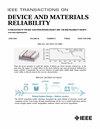DCGAN-Driven Minority Class Augmentation for Lightweight YOLO-Based Photovoltaic Defect Localization Suitable for Edge Deployment
IF 2.3
3区 工程技术
Q2 ENGINEERING, ELECTRICAL & ELECTRONIC
IEEE Transactions on Device and Materials Reliability
Pub Date : 2025-07-24
DOI:10.1109/TDMR.2025.3592416
引用次数: 0
Abstract
This study presents YOLOv11n-GhostLite, an innovative lightweight deep learning architecture optimized for real-time localization of photovoltaic (PV) faults in electroluminescence (EL) images, specifically designed for edge deployment. A Deep Convolutional Generative Adversarial Network (DCGAN)-based synthetic augmentation pipeline is presented to address the issues of class imbalance and limited resource availability, generating high-fidelity, class-conditional EL images that include realistic banding artifacts. This method enhances the representation of minority defect categories by more than 150%, elevating the mean Average Precision (mAP@50) by 4% and decreasing false negatives by 5%. The proposed model incorporates GhostConv for efficient early feature extraction, C3k2 residual blocks for deep representation learning, GhostSPPF for multi-scale context aggregation, C2PSA attention for adaptive feature refinement, and an anchor-free detection head, achieving high performance with only 2.34 million parameters and 6.2 GFLOPs. Detailed experiments on two benchmark datasets PVEL-AD and PV Multi-Defect exhibit the model’s efficacy, attaining 97.2% mAP@50 on PVEL-AD, and 96.4% mAP@50 on PV Multi-Defect, outperforming larger models in both accuracy and speed. The model is further deployed on a Google Coral Edge TPU, demonstrating its real-time functionality with minimal power consumption (~2W) and suitable latency for drone-based solar inspections. YOLOv11n-GhostLite’s integration of efficient architecture and data-driven augmentation renders it an effective solution for scalable, real-time photovoltaic fault detection in resource-limited settings.适合边缘部署的轻量化yolo光伏缺陷定位的dcgan驱动少数派类增强
该研究提出了YOLOv11n-GhostLite,这是一种创新的轻量级深度学习架构,专为边缘部署而设计,针对电致发光(EL)图像中的光伏(PV)故障进行实时定位优化。提出了一种基于深度卷积生成对抗网络(DCGAN)的合成增强管道,以解决类别不平衡和资源可用性有限的问题,生成高保真、类别条件的EL图像,其中包括逼真的条带伪影。该方法将少数缺陷类别的代表性提高了150%以上,将平均平均精度(mAP@50)提高了4%,并减少了5%的假阴性。该模型结合了GhostConv进行高效的早期特征提取,C3k2残差块进行深度表征学习,GhostSPPF进行多尺度上下文聚合,C2PSA关注进行自适应特征细化,以及无锚点检测头,仅使用234万个参数和6.2个GFLOPs就实现了高性能。在PVEL-AD和PV Multi-Defect两个基准数据集上的详细实验证明了该模型的有效性,在PVEL-AD上达到97.2% mAP@50,在PV Multi-Defect上达到96.4% mAP@50,在准确率和速度上都优于大型模型。该模型进一步部署在谷歌Coral Edge TPU上,以最小的功耗(~2W)和适合无人机太阳能检测的延迟展示了其实时功能。YOLOv11n-GhostLite集成了高效的架构和数据驱动的增强功能,使其成为资源有限环境下可扩展的实时光伏故障检测的有效解决方案。
本文章由计算机程序翻译,如有差异,请以英文原文为准。
求助全文
约1分钟内获得全文
求助全文
来源期刊

IEEE Transactions on Device and Materials Reliability
工程技术-工程:电子与电气
CiteScore
4.80
自引率
5.00%
发文量
71
审稿时长
6-12 weeks
期刊介绍:
The scope of the publication includes, but is not limited to Reliability of: Devices, Materials, Processes, Interfaces, Integrated Microsystems (including MEMS & Sensors), Transistors, Technology (CMOS, BiCMOS, etc.), Integrated Circuits (IC, SSI, MSI, LSI, ULSI, ELSI, etc.), Thin Film Transistor Applications. The measurement and understanding of the reliability of such entities at each phase, from the concept stage through research and development and into manufacturing scale-up, provides the overall database on the reliability of the devices, materials, processes, package and other necessities for the successful introduction of a product to market. This reliability database is the foundation for a quality product, which meets customer expectation. A product so developed has high reliability. High quality will be achieved because product weaknesses will have been found (root cause analysis) and designed out of the final product. This process of ever increasing reliability and quality will result in a superior product. In the end, reliability and quality are not one thing; but in a sense everything, which can be or has to be done to guarantee that the product successfully performs in the field under customer conditions. Our goal is to capture these advances. An additional objective is to focus cross fertilized communication in the state of the art of reliability of electronic materials and devices and provide fundamental understanding of basic phenomena that affect reliability. In addition, the publication is a forum for interdisciplinary studies on reliability. An overall goal is to provide leading edge/state of the art information, which is critically relevant to the creation of reliable products.
 求助内容:
求助内容: 应助结果提醒方式:
应助结果提醒方式:


